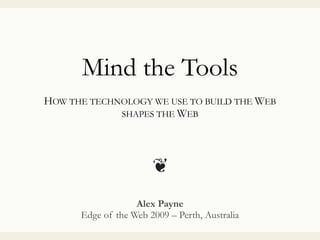
Mind The Tools
- 1. Mind the Tools HOW THE TECHNOLOGY WE USE TO BUILD THE WEB SHAPES THE WEB Alex Payne Edge of the Web 2009 – Perth, Australia ❦
- 2. Introduction ❖ Working on Twitter since January, 2007. ❖ Working on the Web since age 12 (1995). ❖ A bit nuts about programming languages. ❖ Co-author of Programming Scala from O’Reilly (October, 2009).
- 4. How does language shape what we do?
- 6. Agenda i. A little history. ii. A tour of the present. iii. Gazing into the future. iv. How languages and tools shaped the web.
- 7. A Brief History Programming Languages of the Web
- 8. In The Beginning... ❖ HTML born in 1990-91. ❖ First proper public specification of HTML arrives in 1993. ❖ NCSA Mosaic 1.0 released in April, 1993, just as CERN announces that the Web will be free and open. ❖ CGI standard emerges in 1993, enabling the earliest web applications.
- 10. The CGI Era ❖ 1993 - 1997. ❖ Most common languages for CGI scripts: ❖ C ❖ Perl ❖ Reduces data to key-value pairs. ❖ The primordial soup of web applications.
- 12. The Applet Era ❖ 1995 - 1997. ❖ A showcase for the Java language. ❖ The first “dynamic” content on the Web. ❖ Solid security model, impressive demos, but never really took hold. ❖ Killed by Microsoft’s unbundling and the rise of Flash in the early naughts.
- 15. The Flash Era ❖ 1998 - present ❖ Started out as simply a solution for vector-based animation. ❖ For a while, a competitor to “DHTML”. ❖ Now used mostly for delivering video and games. ❖ Deep concern in the Web standards and FOSS communities about its use.
- 16. The JavaScript Era ❖ 1998 - present. ❖ From animations and client-side form validations to web application greatness. ❖ Much maligned, must misunderstood. ❖ Now one of the most widely-deployed languages in existence.
- 18. The PHP Era ❖ 1998 - 2005 ❖ The first programming language built explicitly for web development. ❖ Decent performance, fast development cycle. ❖ Encourages poor programming practices. ❖ Also spawned ASP.
- 19. The LAMP Era ❖ 2001 - 2007 ❖ Python catches up to PHP. ❖ Perl is still around. ❖ Generic interfaces like FCGI enable a “right tool for the job” mentality. ❖ Open source web servers and databases have matured.
- 20. The Age of Frameworks ❖ 2005 - present. ❖ Ruby on Rails, Django, and many copycats. ❖ Codifying best practices, treating web application development like “real” software development. ❖ Increased productivity, but at the cost of vendor dependency.
- 21. Timeline 1991 1992 1993 1994 1995 1996 1997 1998 1999 2000 2001 2002 2003 2004 2005 2006 2007 2008 2009 CGI (Perl, C) 1993 – 1997 JavaScript 1998 – 2009 frameworks (Rails, Django, et. al.) 2005 – 2009 Flash (ActionScript) 1998 – 2009 The Web opens up 1993 Applets (Java) 1995 – 1997 HTML born 1990 – 1991 PHP 1998 – 2005 LAMP (Python, PHP, Perl) 2001 – 2007 VRML 1995 – 1997
- 22. Charted Territory Typing Object Model Compilation Perl Python PHP Ruby JavaScript ActionScript Java dynamic class-based interpreted dynamic class-based interpreted dynamic class-based interpreted dynamic class-based interpreted dynamic prototype-based interpreted static prototype-based compiled static class-based compiled
- 23. Lessons of History ❖ Dynamic, interpreted languages have been dominant on the Web. ❖ Languages built exclusively for the Web face tough criticism (PHP, JavaScript). ❖ No one technology lasts forever – and that’s a good thing.
- 24. The Present
- 25. Frameworks Everywhere ❖ Application frameworks: Rails, Django. ❖ JavaScript frameworks: jQuery, YUI. ❖ CSS frameworks: Blueprint, Baseline. ❖ Typography frameworks (?!): TypeKit, sIFR.
- 26. APIs Everywhere ❖ Not just for mashups anymore. ❖ Eat your own dog food: API as systems architecture. ❖ Letting data escape the browser model.
- 27. JavaScript Everywhere ❖ Use the same language, front-to-back. ❖ Perfect for AJAX-heavy applications. ❖ JSON as universal object format. ❖ A bit untested, but AppJet and others are paving the way.
- 28. Code Generation ❖ Use the same language for everything, but compile down to HTML, CSS, and JavaScript. ❖ Google Web Toolkit (GWT). ❖ Popular in the Ruby and functional language communities.
- 29. Refining Standards ❖ HTML 5, JavaScript 1.9 ❖ new challenges: ❖ mobile ❖ geolocation ❖ heavyweight web applications (GMail, etc.) ❖ old and difficult challenges: ❖ internationalization ❖ accessibility
- 30. The Web Outside The Browser ❖ Taking web development to other realms: ❖ the desktop (AIR, Titanium) ❖ mobile (Palm webOS) ❖ Why build your own development model?
- 31. The Future
- 32. The Post-Framework Era ❖ Message queues connecting heterogeneous components. ❖ Trickle-down SOA. ❖ Back to LAMP, only language doesn’t matter this time. ❖ And, yes, finally, the Cloud.
- 33. The Native Era ❖ Google Native Client. ❖ Getting video out of Flash. ❖ Mobile apps.
- 34. The Functional Era ❖ Functional languages fit the Web development model. ❖ It’s taken time for the old FP languages (Lisp, Haskell, OCaml) to build up Web tooling. ❖ Newer functional languages (Scala, Clojure) are already productive and competitive for Web work. ❖ Even newer FP languages are aimed squarely at the Web (Arc, Ur).
- 35. How Does All This Shape The Web?
- 36. Dynamism.
- 37. Tension.
- 38. Heterogeneity.
- 39. Evolution.
